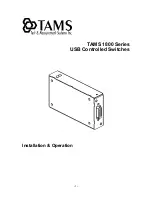
5-18
Catalyst 4500 E-Series Switches Installation Guide
OL-13972-02
Chapter 5 Troubleshooting
Contacting the Cisco Technical Assistance Center
Step 7
If you cannot connect to the switch through the me1 interface, make sure the connected device is
configured for half-duplex 10-Mbps operation.
Step 8
If the host is in the same subnet as the switch interface, make sure the switch interface and the switch
port to which the host is connected are assigned to the same VLAN (use the
show interface
and
show
port
commands to check).
Step 9
If the host is in a different subnet, make sure the default gateway (default route) on the switch is
configured with the address of a router in the same subnet as the switch interface (use the
show ip route
command).
Step 10
Check the status of the port connection—should be “connected” (use the
show port
command).
Step 11
Check the spanning-tree state on the port (use the
show spantree
mod_num/port_num
command)—if the
port is in listening or learning mode, wait until the port is in forwarding mode and try to connect to the
host again.
Step 12
Make sure the speed and duplex settings on the host and the appropriate switch ports are correct (use the
show port
command).
Step 13
If the connected device is an end station:
a.
Enable spanning-tree PortFast on the port (use the
set spantree portfast enable
command)—PortFast places the port in forwarding mode immediately, bypassing listening and
learning modes (do
not
use this feature for connections to non-end station devices).
b.
Disable trunking on the port (use the
set trunk
mod_num/port_num
off
command).
c.
Disable channeling on the port (use the
set port channel
port_list
off
command)—you must specify
a valid port range with this command—you cannot specify a single port.
Step 14
Make sure the switch is learning the MAC address of the host (use the
show cam dynamic
command).
Step 15
If possible, try connecting to another port.
Cannot autonegotiate the port speed/duplex
Make sure autonegotiation is configured on both ends of the link (use the
show port
command)—you
cannot configure settings manually on one end of the link and configure the other end of the link for
autonegotiation. If autonegotiation fails when you connect a client NIC to the switch, check the NIC and
drivers to make sure that autonegotiation is supported.
If autonegotiation is supported and properly configured but you still cannot connect, turn off
autonegotiation and set the speed and duplex manually (use the
set port speed
and
set port duplex
commands).
Contacting the Cisco Technical Assistance Center
If you are unable to solve a startup problem after using the troubleshooting suggestions in this chapter,
contact a Cisco TAC representative for assistance and further instructions.
Before you call, have the following information ready to help the Cisco TAC assist you as quickly as
possible:
•
Date you received the switch
•
Chassis serial number
•
Type of software and release number















































